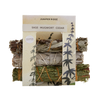
Exploring the many Ecosystems of Sand to Snow National Monument
[Originally Published In 2020]
We always look forward to challenging our skill set, to craft the perfect combination of flora that encapsulates a region, and the Sand to Snow field lab lets us explore and push our own aromatic boundaries. Found in San Bernardino County, the Sand to Snow Monument offers up a rich diversity like few other places on earth. We’ve been hard at work exploring the Sand to Snow Monument, and we think we’ve captured the complexity of the various ecosystems of the region in our newest field lab.
The Serrano and Cahuilla indigenous peoples consider the San Gorgonio Mountain sacred, and have made their home at the base for generations, living amongst the abundant diversity the region provided for food and medicinal plants. The pass running through the monument was also a major trade route for indigenous peoples moving goods from Arizona all the way to the California Coast.
The region ranges from low desert terrain to high alpine peaks, and houses three separate ecosystems--each with its own distinct feel, flora and fauna. In fact, it is one of the most biodiverse regions we’ve ever encountered. The national monument is sandwiched between the coast to the west, the Mojave Desert to the east, and the Sonoran desert to the south. You can find yourself at the sea level desert floor, or at the top of the San Bernardino Mountains, namely the monument’s centerpiece, 11,500 feet on Southern California’s highest peak San Gorgonio Mountain, taking in the breathtaking views of the desert below you. All of this within 154,000 acres.
More than 1,600 different species of plants, over 240 species of birds, and 12 animals on the threatened or endangered list call the monument home. The monument serves an important role in protecting these species, and its journey as a protected region began with that in mind, conserving the wildlife that moves between the San Gorgonio Wilderness, Joshua Tree National Park, and the Bighorn Mountain Wilderness.
The monument is a beautiful success story in preserving the land and keeping it out of the hands of developers, especially in a time where the federal government is opening up more public lands to companies eager to strip them of their resources. Sand to Snow was declared a national monument in very recent history, back in 2016 during the Obama administration. But it was the work of local conservancy groups that really brought the monument to fruition. Since the beginning of the 20th century, conservancy groups have slowly started purchasing and gathering land to protect the wildlife corridor between the different wilderness regions that Sand to Snow is smack dab in the middle of. It was only then, once the land was under the ownership of a non-profit conservancy, that the federal government declared it a national monument and placed it under federal protection. The monument is now co-managed by the U.S. Forest Service and the Bureau of Land Management, all thanks to the work of local activists.
This kind of work is vital, and there are numerous groups in Southern California helping to do it. Through our Wilderness Defense Fund, we’ve supported the efforts of Mojave Desert Land Trust, which formed back in 2006. In the last 14 years they have carried out their mission of protecting the Mojave Desert, conserving more than 80,000 acres of desert habitat, hoping to create more unobstructed wildlife corridors.
This field lab celebrates the work of conservation groups who’ve protected this unique place for generations to come. Ranging from the high rocky crags to the riparian woodlands, and to the oases that glitter the landscape of the Sand to Snow monument, we’ve combined over six native plants, all sourced sustainably, to remind you of the inspiring region. With its scent notes of earthy wood, refreshing herbs, and bright citrus, we hope you enjoy touring the Sand to Snow monument from your own home with our newest field lab.























